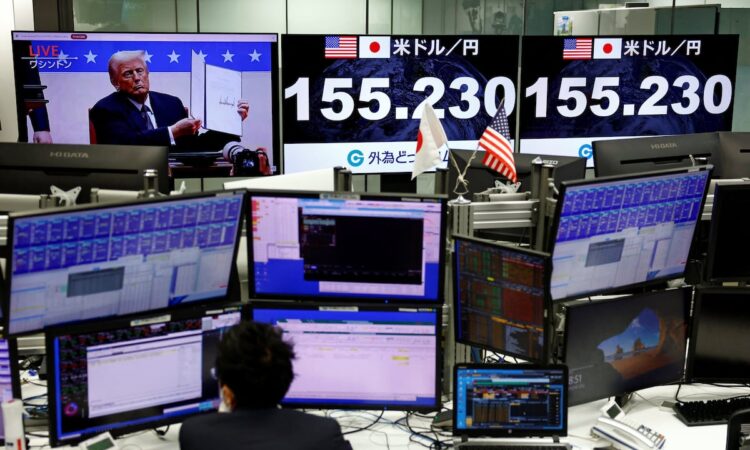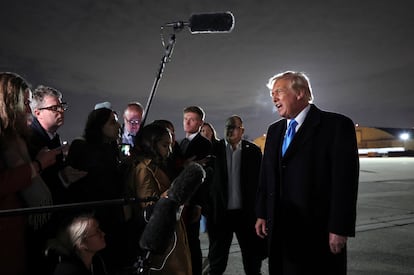Dollar soars and stock markets fall sharply after Trump’s tariff war begins | Economy and Business

The tariffs on U.S. imports from Mexico, Canada and China decreed by Donald Trump this Saturday have caused an earthquake in the financial markets. Since trading opened in Asia, the dollar has soared against the main currencies and is approaching parity with the euro. The Canadian dollar meanwhile has fallen to a new historic low against the U.S. currency, while the Mexican peso has depreciated to its lowest level since the end of 2021. At the same time, futures on the S&P 500, the main U.S. stock index, and the Euro Stoxx 50, the European index, are trading lower and oil has become more expensive. Uncertainty and increased aversion to risk have led to declines of more than 20% in some cryptocurrencies. On Friday, before the end of the trading day, the effects of the protectionist measures were already being felt in the financial markets.
Investors and analysts are trying to put together the pieces of the new geoeconomic puzzle posed by the start of Trump’s trade war, which has already been met with a reply by the affected parties, but which could spread to more products and regions. As part of the most notable protectionist attack by the United States in more than a century, Trump plans to begin imposing tariffs on the import of oil, semiconductor chips, aluminum, steel and pharmaceutical products starting this month. His roadmap also includes the imposition of universal tariffs. The euro zone will not be free from either one, according to the Republican’s plans.
There are several factors that explain the relative strength of the dollar. On the one hand, it involves a readjustment of the real terms of trade. That is to say, the implementation of tariffs weakens the demand for products from Mexico and Canada and, with it, the economies of those countries. They are expected to regain competitiveness via the exchange rate by adjusting the parity of their currencies. On the other hand, tariffs could have inflationary effects, which may force the Federal Reserve to maintain higher interest rates for longer, widening the gap with the rates of the European Central Bank and making investments in dollars relatively more attractive. Short-term U.S. Treasury debt rates are increasing their yield this Monday. In addition to the adjustment of the terms of trade and the prospect of higher rates, there is also the dollar’s role as a safe haven currency in times of turbulence.
With all these ingredients in place, the exchange rate fell on Monday to just 1.02 dollars per euro, matching the lows of a few weeks ago, which are also the closest to parity since November 2022, when the dollar’s value exceeded that of the euro. The U.S. currency has reached the equivalent of 1.47 Canadian dollars, which is a historic low for the latter. In the case of Mexico, one dollar was being exchanged on Monday for 21.20 Mexican pesos, which means that the currency of the country presided by Claudia Sheinbaum is at its lowest level since November 2021.
Trump on Sunday told reporters that he would speak with Canadian Prime Minister Justin Trudeau and Mexican President Claudia Sheinbaum on Monday, one day before the 25% tariffs on their products go into effect. “I’m speaking with Prime Minister Trudeau tomorrow morning, and I’m also speaking with Mexico tomorrow morning. And I don’t expect anything very dramatic. We put tariffs on. They owe us a lot of money, and I’m sure they’re going to pay,” Trump said.
Asked what Canada and Mexico have to do to get the tariffs lifted, Trump again made it clear that fentanyl and immigration, the official excuses, are more of a pretext and that what this is really about is an economic war. “They have to balance out their trade, number one. They’ve got to stop people from pouring into our country, and we’ve stopped it. They haven’t stopped it. We’ve stopped it. They have to stop people pouring in, and we have to stop fentanyl. And that includes China,” he replied.

Strong punishment for exporting companies
On the Asian stock markets, which began trading on Sunday in the United States and early Monday morning in Europe, exporting companies suffered a severe punishment, especially those with investments in Canada and Mexico from which they access the U.S. market, but also others that may be affected by future tariffs.
According to Bloomberg data, Samsung Electronics opened trading down 3% to a low of 51,000 won, hovering around the lowest level since mid-2020. Samsung, a major chip supplier, assembles some of the home appliances it exports to the United States in Mexico. LG Electronics, which also assembles some home appliances such as refrigerators in Mexico, fell 5.2% to its lowest level since October 2022. Automaker Kia, which has a plant in Mexico, fell 3.6% and its supplier HL Mando 5.8%. LG Energy Solution, which operates a battery module joint venture with Stellantis in Canada, plunged 4.4%. Posco Future M, which invested in a joint venture with GM in Canada to produce materials for electric vehicle batteries, plunged 7.8% to its lowest level since August 2022.
The Australian stock market also opened with sharp falls, dragged down by mining companies such as BHP and Rio Tinto, which could be directly and indirectly affected by Trump’s tariffs. In Taiwan, it was the collapse of the chip manufacturer TSMC that caused the stock market index to fall by more than 4%.
Euro Stoxx 50 futures opened down more than 3%, anticipating a bloodbath at the opening of European stock markets. Trump took it for granted on Friday that there will be tariffs for the euro zone and that they will come fairly soon. Exporting companies may feel the blow, but so will others with strong interests in Mexico, such as BBVA, the leader of the country’s banking sector, which has already warned of the risk that tariffs entail for its business in Mexico.
The S&P 500 fell on Friday when the White House confirmed that Trump would impose tariffs. As U.S. markets reopen, the stock prices of car companies such as General Motors and Ford, whose supply and production chains are largely integrated with neighboring countries, will need to be kept in particular close watch. Electric car manufacturers Tesla and Rivian could also suffer.
Oil and cryptocurrencies
Oil also rose sharply at the start of the week’s trading. West Texas Intermediate (WTI), the U.S. benchmark, was up as much as 3.7% to $75.18 a barrel, while Brent crude gains were close to 2% to around $76. Potential distortions in the U.S. crude and refined petroleum products market have caused the spread between Brent and WTI to narrow. Gasoline futures on the New York market have risen more than 6%.
In principle, it is these potential disruptions introduced by tariffs (10% for Canadian energy and 25% for Mexican energy) that explain the temporary rise in prices. However, if the trade war that has just begun slows down the global economy, lower demand and a fall in oil prices are to be expected.
Cryptocurrencies have not been spared from the turmoil, either. Ether, the second-largest digital asset by market value, fell by more than 26% at the opening, before reducing its losses. Bitcoin suffered losses of more than 5% and other cryptoassets also fell at the opening of the Asian markets.
Sign up for our weekly newsletter to get more English-language news coverage from EL PAÍS USA Edition




